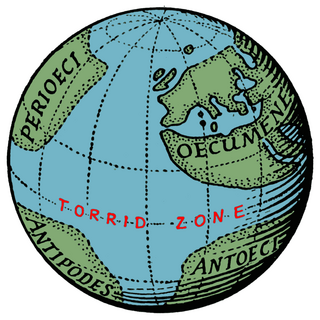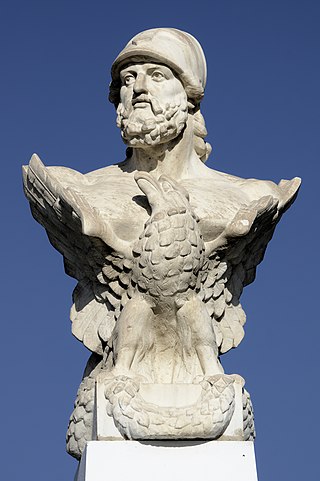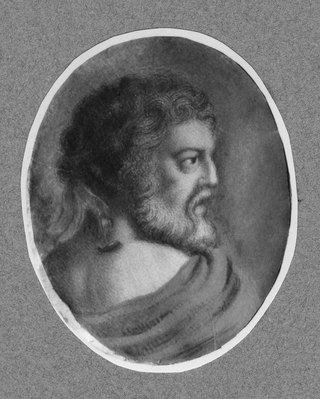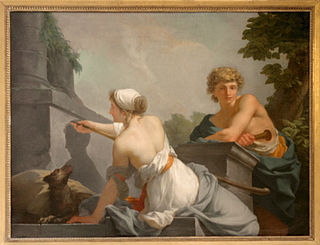
In Greek mythology, Daphnis was a legendary Sicilian cowherd who was said to be the inventor of pastoral poetry. According to Diodorus the Sicilian, Daphnis was born in the Heraean Mountains of central Sicily.
Agoracritus was a famous sculptor in ancient Greece.
Polygnotus was an ancient Greek painter from the middle of the 5th century BC.

Gnaeus Pompeius Trogus(fl. 1st century BC), also anglicized as Pompey Trogue, was a Gallo-Roman historian from the Celtic Vocontii tribe in Narbonese Gaul who lived during the reign of the emperor Augustus. He was nearly contemporary with Livy.

Apelles of Kos was a renowned painter of ancient Greece. Pliny the Elder, to whom much of modern scholars' knowledge of this artist is owed, rated him superior to preceding and subsequent artists. He dated Apelles to the 112th Olympiad, possibly because he had produced a portrait of Alexander the Great.

Crates of Mallus was a Greek grammarian and Stoic philosopher, leader of the literary school and head of the library of Pergamum. He was described as the Crates from Mallus to distinguish him from other philosophers by the same name. His chief work was a critical and exegetical commentary on Homer. He is also famous for constructing the earliest known globe of the Earth.
Callias was an Ancient Greek statesman, soldier and diplomat active in 5th century BC. He is commonly known as Callias II to distinguish him from his grandfather, Callias I, and from his grandson, Callias III, who apparently squandered the family's fortune.
Nicomachus of Thebes was an ancient Greek painter, a native of Thebes, and a contemporary of the great painters of the Classical period. He trained under his father Aristides, also a painter.

Chilon of Sparta was a Spartan and one of the Seven Sages of Greece.

Timanthes of Cythnus was an ancient Greek painter of the fourth century BC. The most celebrated of his works was a picture representing the sacrifice of Iphigenia, in which he finely depicted the emotions of those who took part in the sacrifice; however, despairing of rendering the grief of Agamemnon, he represented him as veiling his face. Zeuxis Timanthes and Parrhasius were painters who belonged to the Ionian School of painting. The Ionian School flourished during the 4th-century BCE.

Cimon or Kimon was an Athenian strategos and politician.

Protogenes was an ancient Greek painter, a contemporary rival of Apelles. As with the other famous ancient Greek painters, none of his work has survived, and it is known only from literary references and (brief) descriptions.

Euphranor of Corinth was a Greek artist who excelled both as a sculptor and as a painter.
Parrhasius of Ephesus was a famed painter of Ancient Greece. Zeuxis, Timanthes and Parrhasius were painters who belonged to the Ionian School of painting. The Ionian School flourished during the 4th-century BCE.

Boëthus was a Greek sculptor of the Hellenistic age. His life dates cannot be accurately fixed, but he probably flourished in the 2nd century BCE. One source gives his birthplace as Chalcedon.
Choerilus was an Athenian tragic poet, who exhibited plays as early as 524 BC.
Pausias was an ancient Greek painter of the first half of the 4th century BCE, of the school of Sicyon.

Butades of Sicyon, sometimes mistakenly called Dibutades, was the reputed inventor of the art of modelling clay in relief. An accident first led him to practise, in conjunction with his daughter, at Corinth. The period at which he flourished is unknown, but has been estimated at 600 BC.
Dipoenus and Scyllis were early ancient Greek sculptors from Crete who worked together and were said to have been pupils of Daedalus. Pliny assigns to them the date 580 BC, and says that they worked at Sicyon, which city from their time onwards became one of the great schools of sculpture. They also made statues for Cleonae and Argos. They worked in wood, ebony and ivory, and apparently also in marble.
Philon, Athenian architect of the 4th century BC, is known as the planner of two important works: the portico of twelve Doric columns to the great Hall of the Mysteries at Eleusis and, under the administration of Lycurgus, an arsenal at Athens. Of the last we have exact knowledge from an inscription. E. A. Gardner observes that it "is perhaps known to us more in detail than any other lost monument of antiquity." It was to hold the rigging of the galleys; and was so contrived that all its contents were visible from a central hall, and so liable to the inspection of the Athenian democracy. He is known to have written books on the Athenian arsenal and on the proportions of temple buildings, but these are now lost.











